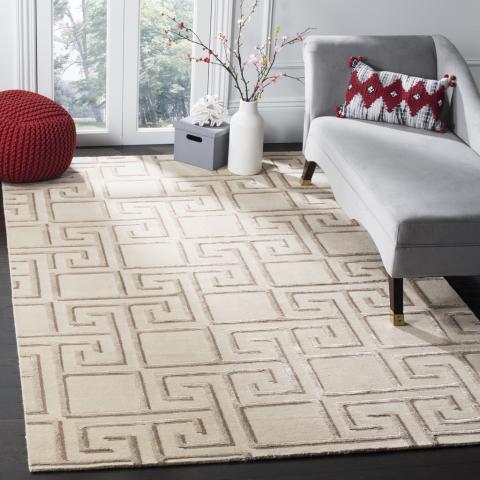Area Rug Materials & Dyes
|
There are approximately one thousand breeds of sheep in existence, but only a few types provide the wool used for carpet weaving. The shoulder wool is the longest and most expensive. It provides superior strength, resilience, softness, and durability. Often the wool from different breeds of sheep is blended together. This is done to reduce the cost of the carpet, or to combine the best properties of each type of wool.
In terms of durability, the type of wool used in the rug is very important. The drier wool (market wool) tends to wear out faster and absorb stains more readily. These come from a variety of sources, often local to the area of weaving. On the other hand, a wool rich with lanolin, which is an oil found naturally in the wool, will last longer, is more resilient, and takes the dye better to produce a wider variety in color. It also cleans much more easily than a drier wool because the lanolin acts as a repellent; the way oil does with water.
This superior quality wool can come from many sources, but among the best are New Zealand and Australia. Other factors include the climate in which the sheep are living and the type of food they eat. Although the wool is not graded per se; it can be described in terms of quality, and should be an instrumental part of the decision making process in choosing the right rug for your needs. There are many steps involved in preparing the wool. First the sheep are sheared. This is similar to a shave and does not harm the sheep. Then the wool is washed, sorted, and carded to remove debris and align the fibers. Next they comb the wool to remove the shorter fibers, which are less durable. Then the longer fibers are twisted and spun together. This determines the strength of the yarn. The more twist, the stronger and harder it becomes. The last step in creating the yarn is called plying. This is a process of twisting the strands together. Three ply is three strands, and so on. |
||
| DYES | ||
| There are three types of dyes used for dying wool yarns. Natural dyes are the oldest and derive from animal or vegetable sources. These, although quite beautiful, are inconsistent, have fewer colors, and may fade over time. They were used in antique rugs because it was the only type available at that time, and are currently used in new rugs to create an antique look. Aniline dyes were very acidic, faded in sunlight, and are no longer used. Chrome dyes are synthetic and were developed to give a wider range of color as well as to produce a colorfast product. These modern dyes are bonded to the wool with potassium bicarbonate, which makes the wool resist fading and doesn't harm the wool. | ||

